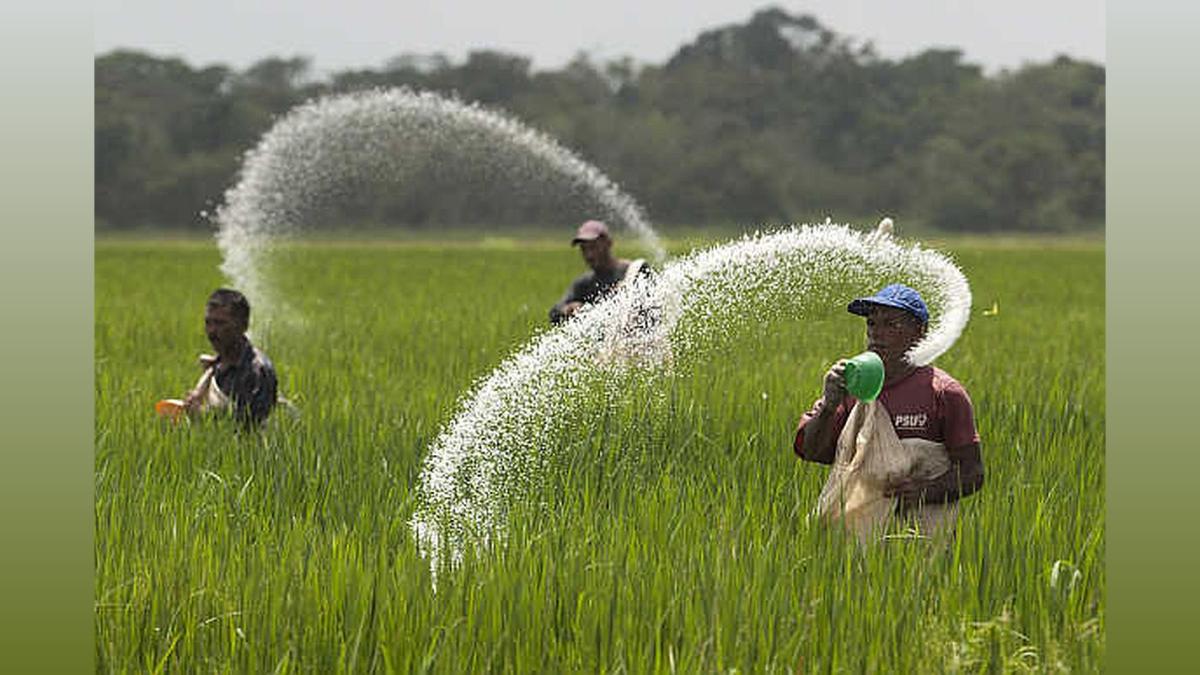Agri Stack: Digital System for Fertiliser Subsidy Targeting
Economic Survey proposes using 'Agri Stack' digital system for targeted fertiliser subsidy distribution, aiming to ensure efficient use and prevent misuse. Read more.

New Delhi, Jul 22 (PTI) Economic Survey has prescribed for better targeting of fertiliser subsidy using 'Agri Stack' digital system to ensure that a fixed quantity of subsidised nutrients are sold to only identified farmers based on parameters such as land ownership and cropping pattern of a particular district.
It also suggested direct transfer of fertilisers subsidy to farmers through E-RUPI, a digital payment mechanism.
Initially, the survey suggested that this system should be used as a pilot in one district of few states.
As per the interim Budget presented in February, the allocation for fertiliser subsidy is Rs 1.64 lakh crore for 2024-25 fiscal as against the revised estimates of Rs 1.89 lakh crore for the preceding financial year.
"Agri Stack is the digital foundation set up by the government to make it easier to bring various stakeholders together to improve agriculture in India and enable better outcomes and results for the farmers by using data and digital services," it said.
The survey noted that the Agri Stack is now fairly well-developed in major Indian states and can provide the right tool through which the fertiliser subsidy might be better targeted.
"This will ensure that subsidised fertilisers are sold to only those identified as farmers or authorised by the farmer, and the quantity of subsidised fertiliser is fixed based on parameters such as land ownership and prominent crops of the district (comprising at least 70 per cent of sown area in a season)," the document said.
The parameters could be later refined based on crop grown and soil nutrient status (in convergence with the soil health card scheme). Provisions might be made to provide top-up entitlement in case of crop damage or calamities caused by volatilities in weather conditions.
"E-RUPI, a seamless one-time payment mechanism, can be utilised to provide the necessary subsidy to the farmer directly. This system ensures that the subsidy can only be used through registered PoS devices at authorised fertiliser outlets," the survey said.
In case a farmer purchases a quantity of fertilisers that is less than their entitlement, the survey said the remaining subsidy can be used to purchase other agricultural inputs, such as seeds and pesticides, also sold at these outlets.
"Any unused subsidy at the end of the year can also be converted into a small savings instrument in the farmer's name at a post office. This system not only streamlines the subsidy distribution process but also prevents the misuse of subsidies for non-agricultural purposes," it said.
This will give an incentive to the farmer not to use excessive urea on account of being cheaper than the other NPK fertiliser and may lead to balanced use of fertilisers as per the requirement of the crop and soil.
"Fertiliser administration reforms have been carried out in other countries, wherein the fertiliser requirement has been based on standard norms. In India, as it involves a paradigm shift and fertiliser is a sensitive subject, it may be prudent to carry out pilots in one district of a few states, which have relatively robust and well-developed agri-stack systems," the survey said.
Based on the results of these pilots, the decision on the future mode of fertiliser subsidy administration could be made, considering all the relevant factors.
At present, urea is being provided to the farmers at a statutorily noti?ed Maximum Retail Price (MRP) of Rs 242 per 45 kg bag of urea (exclusive of charges towards neem coating and taxes as applicable).
The di?erence between the delivered cost of urea at farm gate and net market realisation by the urea units is given as subsidy to the urea manufacturer/importer by the Government of India.
For non-urea, subsidy rates of P&K (potassic and phosphatic) fertilisers are under the Nutrient Based Subsidy (NBS) scheme so that these fertilisers are made available at a?ordable prices to the farmers.
Under the fertiliser DBT (direct benefit transfer) system, 100 per cent subsidy on various fertiliser grades is released to the fertiliser companies on the basis of actual sales made by the retailers to the bene?ciaries.
Sale of all subsidised fertilisers to farmers/buyers is made through point of sale (PoS) devices installed at each retailer shop and the bene?ciaries are identi?ed through Aadhaar Card, KCC, and Voter Identity Card, etc.
It also suggested direct transfer of fertilisers subsidy to farmers through E-RUPI, a digital payment mechanism.
Initially, the survey suggested that this system should be used as a pilot in one district of few states.
As per the interim Budget presented in February, the allocation for fertiliser subsidy is Rs 1.64 lakh crore for 2024-25 fiscal as against the revised estimates of Rs 1.89 lakh crore for the preceding financial year.
"Agri Stack is the digital foundation set up by the government to make it easier to bring various stakeholders together to improve agriculture in India and enable better outcomes and results for the farmers by using data and digital services," it said.
The survey noted that the Agri Stack is now fairly well-developed in major Indian states and can provide the right tool through which the fertiliser subsidy might be better targeted.
"This will ensure that subsidised fertilisers are sold to only those identified as farmers or authorised by the farmer, and the quantity of subsidised fertiliser is fixed based on parameters such as land ownership and prominent crops of the district (comprising at least 70 per cent of sown area in a season)," the document said.
The parameters could be later refined based on crop grown and soil nutrient status (in convergence with the soil health card scheme). Provisions might be made to provide top-up entitlement in case of crop damage or calamities caused by volatilities in weather conditions.
"E-RUPI, a seamless one-time payment mechanism, can be utilised to provide the necessary subsidy to the farmer directly. This system ensures that the subsidy can only be used through registered PoS devices at authorised fertiliser outlets," the survey said.
In case a farmer purchases a quantity of fertilisers that is less than their entitlement, the survey said the remaining subsidy can be used to purchase other agricultural inputs, such as seeds and pesticides, also sold at these outlets.
"Any unused subsidy at the end of the year can also be converted into a small savings instrument in the farmer's name at a post office. This system not only streamlines the subsidy distribution process but also prevents the misuse of subsidies for non-agricultural purposes," it said.
This will give an incentive to the farmer not to use excessive urea on account of being cheaper than the other NPK fertiliser and may lead to balanced use of fertilisers as per the requirement of the crop and soil.
"Fertiliser administration reforms have been carried out in other countries, wherein the fertiliser requirement has been based on standard norms. In India, as it involves a paradigm shift and fertiliser is a sensitive subject, it may be prudent to carry out pilots in one district of a few states, which have relatively robust and well-developed agri-stack systems," the survey said.
Based on the results of these pilots, the decision on the future mode of fertiliser subsidy administration could be made, considering all the relevant factors.
At present, urea is being provided to the farmers at a statutorily noti?ed Maximum Retail Price (MRP) of Rs 242 per 45 kg bag of urea (exclusive of charges towards neem coating and taxes as applicable).
The di?erence between the delivered cost of urea at farm gate and net market realisation by the urea units is given as subsidy to the urea manufacturer/importer by the Government of India.
For non-urea, subsidy rates of P&K (potassic and phosphatic) fertilisers are under the Nutrient Based Subsidy (NBS) scheme so that these fertilisers are made available at a?ordable prices to the farmers.
Under the fertiliser DBT (direct benefit transfer) system, 100 per cent subsidy on various fertiliser grades is released to the fertiliser companies on the basis of actual sales made by the retailers to the bene?ciaries.
Sale of all subsidised fertilisers to farmers/buyers is made through point of sale (PoS) devices installed at each retailer shop and the bene?ciaries are identi?ed through Aadhaar Card, KCC, and Voter Identity Card, etc.
You May Like To Read
TODAY'S MOST TRADED COMPANIES
- Company Name
- Price
- Volume
- Vodafone-Idea
- 11.96 (+ 5.75)
- 113885452
- Sylph-Industries
- 0.77 ( -1.28)
- 51063360
- Mangalam-Industrial
- 0.90 ( -1.10)
- 39473361
- Shish-Industries
- 14.02 ( -9.96)
- 38945873
- Ola-Electric-Mobilit
- 34.40 (+ 9.97)
- 38895972





